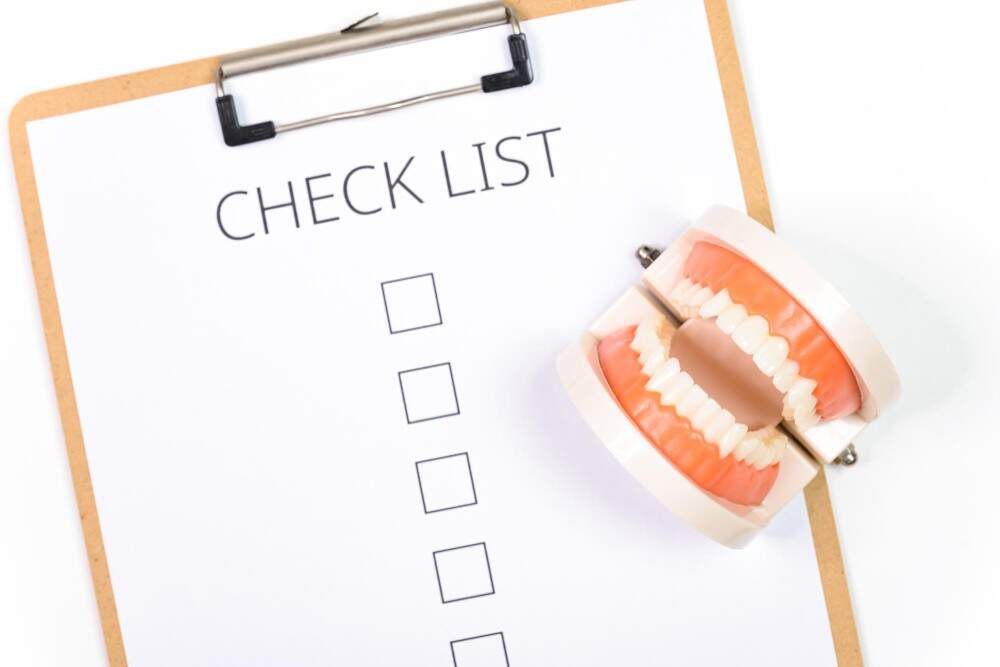All-On-8 dental implants are a one-stage insertion with instantaneous loading. This approach is especially appropriate in cases of total adentia (loss of all the teeth). A single dental arch necessitates 8 to 12-14 dental implants. The important characteristic of this implantation approach is the fact that it doesn’t require bone grafting: in 90% of scenarios, implant insertion can be completed without first correcting jawbone density.
Furthermore, the prostheses are placed directly, allowing the patients to resume their regular life within a few days of the treatment. A fixed denture is implanted within the first 2-3 days of implant placement. This is critical since it restores both the look and the function of the real teeth, enhancing the patient’s self-confidence. Furthermore, the prosthesis is required for bone tissue integrity and implant loading.
What exactly are All-On-8 Implants?
All on 8 is a technique used for individuals who simply need a full replacement for their lost teeth for aesthetic purposes. Any person who has or is struggling from a jawbone condition is not a fit for this surgery.
It is quite similar to the All-On-4 approach in terms of therapy; nevertheless, the distinction is that the prostheses is sustained by eight dental implants rather than four, and it is most usually utilized in patients who have suffered from an injury or ailment.
It is a remedy for several people, and it functions by placing eight implants per tooth arch, which act as “anchors” for a fixed and non-removable dental bridge. These dental implants can sustain a fixed dental bridge containing 12 to 14 components.
Given the short distance between each dental implant on an arch, porcelain or zirconia bridges are indeed the finest materials that dentists utilize for All-On-8 implants. Every single one of these implants experiences less occlusal stress as a result of biting than All-On-4 implants.
Be informed that, in order for the dentist to establish the best course of treatment for you, a 3D dental tomography will really be performed, allowing him/her to assess whether you require bone grafting or sinus lift augmentation prior to implant placement.
All-On-8 installation stages
1st visit
This stage entails an evaluation of the oral cavity, assessment of the situation of the teeth and gums, tomography, synchronization of the treatment plan, sampling of the implantation protocol, installation method, prototype and volume of implants, estimation of the final cost, finishing up the duration of treatment, and establishing the process date.
2nd visit
Performing a technique (ranging from 40 minutes to 3 hours), capturing wax impressions for future manufacturing and customisation of permanent dentures. Throughout this stage, the patient is often given instructions on which drugs to take, how to eat, and how to properly care for the oral cavity.
3rd visit
Regulate inspection of the state of the oral cavity tissues, verifying the reliability of implant installation and fusion in the jawbone, performing a dental panoramic X-ray or tomography, implementing a permanent denture, and providing guidelines on nourishment, style of life, and regulations for sustaining good oral hygiene and tooth health.
Is there another solution to All-On-8?
When there are no or nearly no teeth, jawbone shrinkage, or inflammation of periodontal tissues or the skeletal structure, All on 8 is used. Conventional implantation is not appropriate because it is essential to first boost the quantity of bone tissue prior to actually trying to install the implants, which itself is exceedingly challenging to do with complete adentia because of the substantial amount of work that has to be performed and the long-term rehabilitation that follows such a process. As a result, only analogous implantation procedures with immediate loading offer a viable substitute to All-On-8, and their usage is also feasible in difficult clinical conditions.
What Are the Advantages of All-On-8 Dental Implants?
The most significant benefit of All-On-8 implants is that they’re backed by a lifetime guarantee and provide a natural appearance. Each treatment comes with a unique set of perks, but All-On-8 has proven to be a procedure that several people pick after they understand its clear description and the benefits that it offers. Some of its advantages include:
- These appear to be natural teeth.
- Options for aesthetically pleasing prosthetics.
- The chewing forces are distributed evenly.
- Fixed prostheses for missing teeth.
- Prevents edentulous jaw bone loss.
- Long-term solution.
- Recovery time is reduced.
Am I an appropriate candidate for All-On-8 Implants?
The ideal candidates for this operation are those who are missing most, if not every, of their teeth all along the upper or lower arch, and while enough bone is essential for everyone seeking for dental implant insertion, these techniques do not always require a bone graft. It has been demonstrated that anyone who smokes, uses tobacco products, or has periodontal disease is ineligible for All-On-8 implants.
Some other key factor for you to consider is having a good immune system, which will allow you to recuperate faster. This occurs as a result of the implants’ need to correctly join with the bone during the osseointegration procedure. Among the most compelling reasons why people want All-On-8 implants are:
- If they want to improve their grin.
- If they wish to have a full mouth reconstruction.
- Ordinary implants would require considerable bone density if they did not have adequate jawbones in their mouth.
Comparisons between All-On-8 and other protocols
All-On-4. This is a dental implantation technique used to treat complete or almost complete adentia. Only four dental implants support the detachable denture. In cases of jawbone atrophy, lengthy implants that are placed in the cheekbone can be used to bypass troublesome areas of bone tissue and the sinus area. In 1-3 days, a durable denture is implanted.
All-On-6. Differently from the All-On-4 protocol, the All-On-6 protocol has a broader range of indicators. In cases of more severe atrophy and infection of the periodontal tissues, implantation with six implants is employed since an increased amount of implants provides a more uniform distribution of the mastication load and a superior attachment of the prostheses.
3-on-6. This is the most recent method of dental implantation, involving the use of six bridges (3 at the top and 3 at the bottom). The bridges are affixed to the patient’s gums and provide a very natural-looking appearance. This technique is appropriate for individuals who do not have a bone breakdown, low bone density, or low bone height/width. The condition of the jawbone is critical for successful implantation. 3-on-6 is aimed at individuals who do not presently possess or will soon lose all of their teeth and are searching for a less expensive option to All-On-8 dental implants.
How long will All-On-8 be usable?
All of the existing protocols’ manufacturers offer a lifetime warranty on their products. Dental implants have an average lifespan of at least 20 years. Throughout most circumstances, the quality of the implant is determined by the manufacturer, the pricing, and the procedure used.
Will my teeth look natural after the All-On-8 treatment?
Selecting this type of treatment will undoubtedly help you in a natural-looking manner. All-On-8 implants are designed to offer you a natural appearance as well as the functionality and feeling of your real teeth over time. There is no hesitation that this surgery will make the teeth look very natural, and nobody else is going to be able to tell except if you tell them differently.
What should I do to take care of my implants?
One ought to be extremely diligent with your routine oral care if you want your implants to endure a lifetime. Brushing your teeth is necessary, but it may not always be sufficient for maintaining the area behind your implants clean. In addition to brushing your teeth twice a day, you should utilize water-floss devices to clean beneath the bridge.
How long do dental implants take to fuse to the bone?
Your dental implants require time to fuse to bone before they can osseointegrate with the jaw bone and firmly bind to it. Based on the procedures performed thus far and the outcomes of the patients, it has been determined that this procedure will require approximately three months, with a maximum of six months.
What should I avoid following my dental implants?
There is a special diet you also must keep after getting dental implants, and you ought to be cautious not to abandon it during the first few months, since it may cause difficulties. Hard foods, crunchy meals, difficult and chewy foods, hot foods, and sticky foods are all items to steer clear of. Soups and broth, mashed potatoes, dairy products, oats, soft fruits, and eggs are the main foods you can eat to avoid damaging your implants.
Is the All-On-8 treatment painful?
You should be aware that dental surgery involves trauma to the gums as well as the jaw; nevertheless, doing so does not automatically entail that the procedure will be painful, as the dentist will be using local or general anesthesia on the region where the surgery will be performed, which means you aren’t going to be able to feel anything at the time.
What is the lifespan of All-On-8 dental implants?
Dental implants can be highly advantageous for your oral health based on how you maintain your oral hygiene. The above implies that you ought to brush and floss on a regular basis, and that you ought to see your dentist every six months. This will help your implant screw last a lifetime; meanwhile, the crown generally lasts ten to fifteen years until needing to be replaced due to wear and tear.
Before receiving dental implants, consider the following:
Is there available jawbone space?
Important anatomical structures must be safeguarded whether a patient receives an implant for the lower or upper jaw. It is for this reason that the dentist emphasizes the importance of having the proper jawbone height. The implants can only be inserted by a skilled and knowledgeable dental surgeon.
Are you abusing drugs?
Medications harm the body and can prolong bone and tissue repair. It will be beneficial to discuss this with the dentist before having the treatment performed.
Is the location able to be restored?
Not all jawbone locations are suitable for dental implants. Jawbone abnormalities and other anatomical constraints may preclude you from becoming a suitable match for the implants. It has been demonstrated that success rates vary depending on location. For example, research studies suggest that lower jaw implants have a 98.2% success rate. In accordance with similar studies, this is marginally lower than that of the 97 to 98% rate of success of implants on the upper jaw. Yet, only a skilled oral surgeon can carry out the restoration procedure with such high success rates.
What is the health of gums and the bone like?
Gingivitis and periodontitis can have an impact on the longevity of dental implants. To prevent this from occurring, proper oral hygiene should be prioritized. When an implant fails, a replacement implant is inserted in a somewhat different site that takes advantage of the currently existing bone. The fixed bridge is now parallel to the new implant site.
Is there anything I need to do throughout the osseointegration period?
As previously mentioned, you should be mindful of what you eat during the healing process. Avoid consuming anything chewy, sticky, or firm. It is also critical to maintain the region underneath the temporary denture clean in hopes of preventing infection.
What is the appeal of dental implants?
Dental implants are regarded as the Gold Standard in tooth replacement since they maintain full-mouth restoration faster compared to any other option. Implants provide numerous advantages, along with these three.
Maintain and Strengthen Your Jawbone
Restoring lost teeth is crucial for more than just appearance and function. Every tooth in your mouth contributes to the stimulation and strengthening of the underlying bone. Whenever a tooth is lost, the capacity to safeguard the good bone in that location is lost. Dental implants can replace the tooth’s root system and so continue to stimulate the jawbone. They provide adequate assistance for the jawbone, encourage further bone formation, and prevent any future bone loss. This is the sole approach to avoid bone loss in the long run.
Eat and converse with ease
Tooth loss affects your lifestyle in a variety of ways, most notably your capacity to consume food and speak sans difficulty. Even one missing tooth can have an impact on speech and chewing. Implants are capable of helping replace single or numerous teeth, allowing you to eat your favorite dishes and speak in public without restriction.
Confident Smiling
The most visible issue caused by tooth loss is an incomplete grin. You will feel entirely self conscious smiling and chatting to others if you lose the front teeth or bottom molars. Thankfully, implants can be used to replace lost teeth and restore a full, complete grin. Noone will believe that you had an issue with tooth loss because they appear genuine and authentic.




